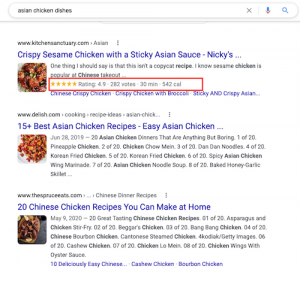We’ve all used Google before to make a quick search about a random thought we had recently. Have you ever noticed the order of the results on the page? Well, most of the time the results are strictly tailored to your particular search, giving you the best answers to your questions mixed with sponsored advertisements. To avoid exhausting much-needed funds for paid search, companies can rely on Search Engine Optimization (SEO) to ensure a more prominent rank in organic search results. Read further for more information on how SEO works when it comes to Google.
What Are You Searching For?
Each time you type a query into Google’s search bar, the Search Engine Results Page (SERP) will generate websites that best match your search. If you are looking for a red dress, for instance, many images and paid shopping ads will appear. On the same side of the coin, if you’re researching for information about different dog breeds, you’ll likely encounter organic results and general information about dogs, including a knowledge graph. Google’s knowledge graph is the rectangular sidebar on the right side of the results page that gives a web user the basic information relating to a search. Not all web searches will have this feature.
Analyzing Google’s SERPs
Google strives to serve up results that match a web user’s search intent. In other words, each Google SERP reflects a user’s specific search, but the results are not always organic. Due to heavy competition, companies feel compelled to have their website show up first by paying Google to appear at the top of page 1. You can identify which web pages are paid results because they have “Ad” written next to the link or “Sponsored” in the upper right-hand corner above the listed images. To locate organic searches, you may have to scroll down until you don’t see the small “Ad” box anymore.
Evaluating Google Snippets
Another feature on the Search Engine Results Page for Google are snippets that give a sneak peek behind certain links. There are three kinds of snippets. The first one being a regular snippet shows the title of the page or article, the link, the day it was published, and the first sentence or two of it. A rich snippet gives a little more information such as the overall rating and an image.

The point of Google snippets is to showcase some extra information, making it more appealing for the viewer to click on. The last snippet is the featured snippet and this is the first box that directly answers the question or phrase you enter into the search bar, giving you the fastest possible response without having to click on any links.
Take Your Web Presence To The Next Level
Many changing variables go into Google’s SERPs, so you won’t always receive the same results every time you conduct a specific search. Understanding how these elements work in tandem with one another can help you earn better search results. More importantly, you can harness the power of SEO to give your company a competitive advantage in the market.
If your company wants more organic traffic, Premiere has the knowledge and expertise to help you climb Google’s ranks until you reach page 1. you could either pay Google for sponsorships and ads or decide to optimize your website to make it more keyword and search engine friendly. Need help with optimizing your website? Contact Premiere Creative at (973) 346-8100 and let our SEO experts develop a strategic SEO plan for your website today.

